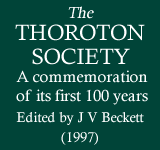1. Introduction: County History and County History Societies
The Thoroton Society was founded at a meeting in the Grand Jury Room of the Shire Hall on 1 June 1897. The Lord Lieutenant of Nottinghamshire, the Duke of St Albans, took the chair, but the driving force behind the new society came from two men: Lord Hawkesbury and W.P.W. Phillimore, the first secretary. The two men had previously been involved in establishing a similar society in Gloucestershire, and Phillimore had the idea of naming Nottinghamshire’s society after the seventeenth-century county historian Dr Robert Thoroton, following precedents set in Warwickshire (the Dugdale Society), Durham (the Surtees Society) and Staffordshire (the William Salt Society). Even so the new society was a gamble: Phillimore told the meeting on 1 June that ‘they had been told that nothing of the kind was possible in Nottingham, and the subject was discouraged, but he was pleased to say that most cordial support had been given’. Although now one hundred years old, the Thoroton Society had in fact arrived rather belatedly on the county society circuit the draft proposals for forming the society noted that ‘Nottinghamshire is almost alone amongst the Counties of England in the want of an independent Society’. One of the characteristics of the new middle classes who emerged in Victorian England was their preference for forming clubs and associations. Many of these were of an intellectual nature, ranging from subscription libraries, through literary and philosophical societies to antiquarian and archaeological societies. The learned society took its place alongside a range of other voluntary and principally charitable organizations.
In local history, the learned societies took two forms: printing clubs and ‘social’ clubs. The printing clubs or societies were passive organizations. Members received a club publication in return for an annual subscription: the earliest were the Surtees Society in Durham founded in 1834, the Camden Society in 1838, and the Chetham Society, founded in Manchester to serve Lancashire and Cheshire in 1843. The ‘social’ societies had a broader remit which included meetings, excursions and events as well as an annual volume of Transactions.
The Society of Antiquaries of Newcastle-upon-Tyne was founded in 1813: later societies included the Historical Society of Lancashire and Cheshire (founded in Liverpool) and the Lancashire and Cheshire Antiquarian Society (founded in Manchester). The Yorkshire Archaeological Society and the Cumberland and Westmorland Antiquarian and Archaeological Society both date from the 1860s. Many others followed, some combining both the printing and social clubs (i.e. issuing editions of archive sources as well as journals and transactions), but others concentrating only on historical and antiquarian matters. The societies were usually based in the county town and brought together the local gentry, the Anglican clergy, and the new middle classes.
It was into this tradition that the Thoroton Society came in 1897. Its main aims were those of all similar societies: the promotion and study of the history and antiquities of the county, the publication of an illustrated annual volume of Transactions, and the convening of local meetings and excursions to places of interest within the county. In fact, the printing of ‘ancient records’, one of the intentions of the founding fathers, began only with the founding of the Record Series in 1903 [1], but in every other respect the fledgling society was typical of its genre. The preliminary list of 109 members included the county aristocracy (four dukes, two earls, a countess, four barons and three baronets), the Bishop of Southwell, the Archdeacon of Nottingham and twenty-five other clergy, members of long established local gentry families (including Denison, Thoroton Hildyard, Mellish, Chaworth Musters and Staunton), and leading members of the Nottingham middle classes, including the Mayor and Sheriff of Nottingham, the town clerk, and others with addresses in the Park and Mapperley.
From those early days it grew into the society we know today. In this commemorative booklet we look back to the work of Dr Robert Thoroton, to the writing of the history of the county since Thoroton’s day and to the work of the Thoroton Society in the twentieth century. ‘There is no shortage of work to be done’, wrote Professor Wood at the time of the Society’s golden jubilee; or in T.M. Blagg’s words in the same volume of Transactions, the society ‘has not done all it set out to do’. ‘Much’, added Blagg, ‘has remained undone’, a sentiment which we can only echo as the Society reaches its centenary and looks forward to its second century. Yet, at the same time, the one hundred volumes of the Transactions, and the wide range of publications noted in the bibliography of Nottinghamshire recently compiled by Michael Brook, show us just what has been accomplished in unravelling the historical, antiquarian and archaeological record of Nottinghamshire since the Society’s pioneers met in the Shire Hall on 1 June 1897.[2]
